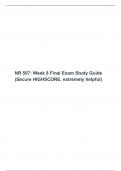Exam (elaborations)
NR507 Final exam Study Guide (set-2), NR 507: Advanced Pathophysiology, Chamberlain College of Nursing.
- Course
- Institution
NR507 Final exam Study Guide (set-2), NR 507: Advanced Pathophysiology, Chamberlain College of Nursing.
[Show more]



